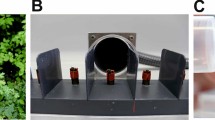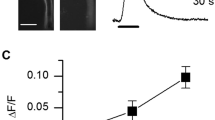Conclusions
-
1.
The snow and snowIaranja mutations, causing accumulation of free tryptophan and serotonin and a deficiency in kynurenins, accelerate the process of alteration of conditioned alimentary reflexes to olfactory signals. A similar action is exerted on injection of tryptophan and serotonin at a dose of 5 μgrams into wild type bees.
-
2.
The ivoryumber and brick mutations, causing accumulation of kynurenin and 3-hydroxykynurenin, respectively, accelerate the formation of conditioned reflexes and prolong the process of their alteration in the case of immobilized bees. A similar action is exerted by an injection of 1 μgram kynurenin into wild type bees.
-
3.
The snowIaranja mutation intensifies the inhibition of the conditioned reflex activity induced normally in wild type bees by monotonous presentation of a conditioned signal. A similar action is exerted by injecting tryptophan at a dose of 5 μgrams into wild type bees.
-
4.
The ivoryumber mutation promotes the maintenance of a higher level of a conditioned reflex activity compared to the normal, on monotonous presentation of a conditioned signal. A similar action is exerted by an injection of 1 μgram kynurenin into wild type bees.
Similar content being viewed by others
Literature cited
A. K. Voskresenskaya, “Conditioned reflexes to color stimulants,” Izv. Akad. Nauk SSSR, Ser. Biol.,1, No. 1, 94 (1955).
E. A. Gromova, Serotonin and Its Role in the Body [in Russian], Meditsina, Moscow (1966), p. 183.
L. Z. Dolotovskaya, “Effect of mutations blocking the activity of the enzyme tryptophanpyrrolase on the rate of development and alteration of alimentary conditioned reflexes of the honey bee (Apis mellifera L.).,” Dokl. Akad. Nauk SSSR,258, No. 4, 997 (1981).
N. G. Kamyshev, “Duration of life and its association with motor activity inDrosophila mutants of the metabolic pathway tryptophan-ommochromes,” Dokl. Adad. Nauk SSSR,253, No. 6, 1476 (1980).
L. V. Krushinskii, Formation of Behavior in Animals under Normal and Pathological Conditions [in Russian], Moscow State University, Moscow (1960), p. 263.
L. A. Kuz'mina, N. G. Lopatina, and V. V. Ponomarenko, “Kynurenin in hereditary impairments of functions of the nervous system and behavior of the honey bee,” Dokl. Akad. Nauk SSSR,245, No. 4, 964 (1979).
L. A. Kuz'mina, N. G. Lopatina, and V. V. Ponomarenko, “Tryptophan in the effect of the snow mutation of the honey bee inhibiting the behavior and function of the nervous system,” Dokl. Akad. Nauk SSSR,245, No. 5, 1236 (1979).
M. D. Kurskii and N. S. Baksheev, Biochemical Basis of the Mechanism of Action of Serotonin [in Russian], Naukova Dumka, Kiev (1974), p. 259.
I. P. Lapin, “Kynurenin pathway of metabolism of tryptophan and its role in the function of the nervous system and in the action of psychotropic preparations,” Zh. Vses. Khim. O-va Im. D. I. Mendeleeva,21, No. 2, 151 (1976).
N. G. Lopatina, V. G. Marshin, I. A. Nikitina, V. V. Ponomarenko, G. P. Smirnova, E. V. Savvateeva, and E. G. Chesnokova, “Effect of some mutations on the behavioral and neurological characteristics of insects,” Zh. Vyssh. Nervn. Deyat.,26, No. 4, 785 (1976).
N. G. Lopatina, E. G. Chesnokova, L. Z. Dolotovskaya, and A. V. Fel'cher, “Effect of serotonin on the function of the nervous system and the behavior of the honey bee,” Fiziol. Zh. SSSR,68, No. 3, 362 (1982).
V. V. Ponomarenko, N. G. Lopatina, V. G. Marshin, I. A. Nikitina, G. P. Smirnova, and E. G. Chesnokova, “Realization of genetic information determining the activity of the nervous system and the behavior of animals of different phylogenetic levels,” in: Current Problems of Behavioral Genetics [in Russian], Nauka, Leningrad (1975), p. 195.
N. K. Popova, E. V. Naumenko, and V. G. Kolpakov, Serotonin and Behavior [in Russian], Nauka, Novosibirsk (1978), p. 302.
I. V. Ryzhov and I. P. Lapin, “Effect of gamma-aminobutyric acid and its derivatives on spasms induced by L-kynurenin and quinolinic acid,” Farmakol. Toksikol.,44, No. 2, 140 (1981).
E. V. Savvateeva, “Comparative study of the conditioned reflex activity of mutant lines ofDrosophila melanogaster selected for neurophysiological characteristics,” Dokl. Akad. Nauk SSSR,242, No. 2, 446 (1978).
G. P. Smirnova, N. G. Kamyshev, and V. V. Ponomarenko, “Motor activity of mutants of the tryptophan-xanthommatin metabolic pathway inDrosophila melanogaster,” Dokl. Akad. Nauk SSSR, 246, No. 2, 472 (1979).
E. G. Chesnokova, V. V. Ponomarenko, and E. Voike, “Effect of mutations leading to an excess or deficiency of kynurenin on the background bioelectrical activity of the second thoracic ganglion of the honey bee,” Dokl. Akad. Nauk SSSR,258, No. 3, 753 (1981).
C. Da Cruz Landim, J. Chaud-Netto, and G. L. Sequi, “Morphological alterations in the compound eyes-color mutants ofApis mellifera L. (Hymenoptera, Apidae),” Rev. Brasil. Genet.,2, No. 3, 223 (1979).
J. H. Dustmann, “Quantitative Untersuchungen zur Tryptophan-Ommochrom-Reaktionskette bei der Wildtyp und Mutanten der Honigbiene,Apis mellifera,” Insect Biochem.,5, No. 4, 429 (1975).
H. Frings, “The loci of olfactory endorgans in the honey bee,” J. Exp. Zool.,97, No. 2, 123 (1944).
H. Janger, L. Schneider, and U. Täuber, “Vergleichende Untersuchungen am Augenpigmentsystem von Wildform und weissaugigen Mutanten der Honigbiene (Apis mellifera),” Cytobiologie,6, No. 4, 427 (1972).
I. P. Lapin and G. F. Oxenkrug, “Intensification of the central serotoninergic processes as a possible determinant of the thymoleptic effect,” Lancet,1, No. 7599, 132 (1969).
I. P. Lapin, “Convulsions and tremor in immature rats after intraperitoneal bolites,” Res. Commun.,10, No. 1, 81 (1978).
B. Smith and D. J. Prockop, “Central-nervous-system effects of ingestion of L-tryptophan by normal subjects,” New Engl. J. Med.,267, No. 11, 1338 (1962).
K. Takeda, “Classical conditioned response in the honey bee,” J. Insect Physiol.,6, No. 3, 168 (1961).
Author information
Authors and Affiliations
Additional information
Translated from Zhurnal Vysshei Nervnoi Deyatel'nosti imeni I. P. Pavlova, Vol. 34, No. 5, pp. 911–919, September–October, 1984.
Rights and permissions
About this article
Cite this article
Lopatina, N.G., Dolotovskaya, L.Z. Effect of tryptophan and its metabolites on conditioned reflex activity of the honey bee. Neurosci Behav Physiol 17, 332–339 (1987). https://doi.org/10.1007/BF01183064
Received:
Issue Date:
DOI: https://doi.org/10.1007/BF01183064




